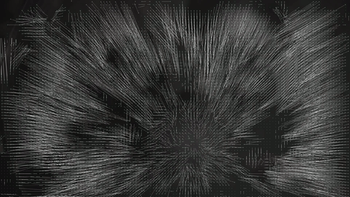Motion estimation

Motion estimation is the process of determining motion vectors that describe the transformation from one 2D image to another; usually from adjacent frames in a video sequence. It is an ill-posed problem as the motion is in three dimensions but the images are a projection of the 3D scene onto a 2D plane. The motion vectors may relate to the whole image (global motion estimation) or specific parts, such as rectangular blocks, arbitrary shaped patches or even per pixel. The motion vectors may be represented by a translational model or many other models that can approximate the motion of a real video camera, such as rotation and translation in all three dimensions and zoom.
Related terms
More often than not, the term motion estimation and the term optical flow are used interchangeably. It is also related in concept to image registration and stereo correspondence. In fact all of these terms refer to the process of finding corresponding points between two images or video frames. The points that correspond to each other in two views (images or frames) of a real scene or object are "usually" the same point in that scene or on that object. Before we do motion estimation, we must define our measurement of correspondence, i.e., the matching metric, which is a measurement of how similar two image points are. There is no right or wrong here; the choice of matching metric is usually related to what the final estimated motion is used for as well as the optimisation strategy in the estimation process.
Algorithms
The methods for finding motion vectors can be categorised into pixel based methods ("direct") and feature based methods ("indirect"). A famous debate resulted in two papers from the opposing factions being produced to try to establish a conclusion.[1][2]
Direct methods
- Block-matching algorithm
- Phase correlation and frequency domain methods
- Pixel recursive algorithms
- Optical flow
Indirect methods
Indirect methods use features, such as corner detection, and match corresponding features between frames, usually with a statistical function applied over a local or global area. The purpose of the statistical function is to remove matches that do not correspond to the actual motion.
Statistical functions that have been successfully used include RANSAC.
Additional note on the categorization
It can be argued that almost all methods require some kind of definition of the matching criteria. The difference is only whether you summarise over a local image region first and then compare the summarisation (such as feature based methods), or you compare each pixel first (such as squaring the difference) and then summarise over a local image region (block base motion and filter based motion). An emerging type of matching criteria summarises a local image region first for every pixel location (through some feature transform such as Laplacian transform), compares each summarised pixel and summarises over a local image region again.[3] Some matching criteria has the ability to exclude points that does not actually correspond to each other albeit producing a good matching score, others does not have this ability, but they are still matching criteria.
Applications
Video coding
Applying the motion vectors to an image to synthesize the transformation to the next image is called motion compensation. As a way of exploiting temporal redundancy, motion estimation and compensation are key parts of video compression. Almost all video coding standards use block-based motion estimation and compensation such as the MPEG series including the most recent HEVC.
See also
References
- ↑ Philip H.S. Torr and Andrew Zisserman: Feature Based Methods for Structure and Motion Estimation, ICCV Workshop on Vision Algorithms, pages 278-294, 1999
- ↑ Michal Irani and P. Anandan: About Direct Methods, ICCV Workshop on Vision Algorithms, pages 267-277, 1999.
- ↑ Rui Xu, David Taubman & Aous Thabit Naman, 'Motion Estimation Based on Mutual Information and Adaptive Multi-scale Thresholding', in Image Processing, IEEE Transactions on , vol.25, no.3, pp.1095-1108, March 2016.